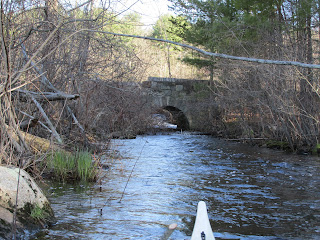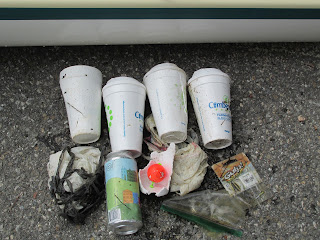Picked up this week where my last post ended by visiting more sites related to the internment of Native Americans, aka Praying Indians, on Boston Harbor's Deer Island. Over the course of the week I walked from where the Massachusetts Bay Colony's General Council held court to the tip of Boston's Long Wharf; paddled the Charles River to where the Natick Praying Village was once centered; paddled the Sudbury River to where one of the earliest bridges (dating to 1640s) was located on the road to Lancaster, MA; walked around the Redemption Rock area near Mount Wachusett; and paddled Asnacomet Pond in Hubbardston, MA. Most of these locales were visited by the Praying Indian, Tom Doublet, who was allowed to leave internment on Deer Island in order to carry letters to and from the the parties engaged in King Philip's War.
Started on Sunday morning with a paddle from Bridge St. in Dover, MA down the Charles River to where the Natick Praying Village was located in present-day South Natick situated about 40 miles by river from Boston Harbor...
...with a side trip up Indian Brook along the way...
According to Ron McAdow in his Charles River guidebook, a mill for grinding grain was built on the brook by Englishman Thomas Sawin at the invitation of the Natick Praying Indians around 1692. Thus Sawin became the first non-Indian resident of Natick. The brook "became know as Sawin Brook, but is now called Indian Brook." The mill was located within the Broadmoor Wildlife Sanctuary.
Further downriver I passed under the arched pedestrian bridge...
...before reaching where the Praying Village was located. The view across the falls to where the village was centered (their church once stood to the right of the brick building)...
It was from here that the Praying Indians were removed from their homes and sent overland to Watertown on October 30, 1675. According to Daniel Gookin, they waited there until midnight when the tide allowed for their being transferred by boat to Deer Island. The Natick Praying Indians were later joined there by other Indians from other praying villages, including Ponkapoag and Nashoba. When the English authorities needed someone to find and deliver a letter to the hostile Indian forces at Mount Wachusett it was Tom Doublet (aka Nepanit), a Nashoba Indian, who stepped forward. With the council's approval Gookin brought Tom to his house in Cambridge, MA. On Monday April3,1676 Tom left from there and journeyed to Wachusett.
On Tuesday, thinking of Tom's journey, I paddled a stretch of the Sudbury River in Wayland where I suspect he may have passed. Launched at Sherman's Bridge and headed upriver...
With the water levels so high it was possible to take short-cuts through the woods and pass by a hunter's unoccupied deer stand...
The water level was high enough to allow my paddling over to the Haynes Garrison House location...
...where colonists were under attack on April 21, 1676...this battle occurring only a few weeks either side of Tom's passing through the area.
The abandoned bridge over the river's original course...
...where an earlier structure allowed carts to pass. Tom may have used the earlier bridge...
Eight men from Concord died there on April 21,1676 and are buried near the bridge's east end...

A train trip into Boston on Wednesday allowed for a visit to the Long Wharf...
....where from its tip one can see Deer Island some 4 miles out (to the right center behind the yellow airplane)...
Turning about one can look up State Street from the Long Wharf to the Old State House...
A closer look at the spot where in 1676 stood the Town House where the General Court held session...
The plan to start negotiations with the warring tribes at Wachusett was most likely devised here.
On Friday, a visit was paid to Mount Wachusett where remnants of winter can still be seen...
...and nearby the locale known as Redemption Rock...
...where the inscription tells of how the negotiations (that started with Tom Doublet's delivery of that first letter) came to fruition...
Tom made three trips to Wachusett: two in April -the first was solo; the second with fellow Praying Indian, Peter Conway (aka Tataquinea). A third trip in early May included John Hoar of Concord, a man friendly towards the Indians, who paid the ransom for Mrs. Rowlandson's redemption. Tom later made additional trips to secure the release of other hostages.
Before leaving the Wachusett area I paddled Asnacomet Pond in Hubbardston, MA. I'd driven past the pond on many occasions and enjoyed finally getting out on it. Its outlet flows into the East Branch of the Ware River...

Imagine my surprise in coming across a floating beer can named for the historical site I'd just visited...

Some wildlife encountered during the week included this pair of buffleheads on the Charles River...
...and this solitary mushquash on the Sudbury River...
Trash included a floating emoji on the Charles...
Trash from the Charles...

Trash from the Sudbury...
Trash from Asnacomet Pond...
In May of 1676 the General Court issued an order ending the internment of the Praying Indians, but not supplying any funds to help in their transport back to the mainland. Daniel Gookin and John Eliot used their own money in paying those costs. Most of the survivors went to Natick while some 50 or so returned to Nashoba where, according to Gookin, "were living there quietly and unmolested".
So, what happened to Tom Doublet? In searching for more information regarding this Native American man I found the following:
In Charles H. Wolcott's Concord in the Colonial Period (1884) there was this Oct. 2, 1660 court record Walcott referenced in showing the colonists' bad disposition towards Indians: "Thomas Dublet, a Concord Indian, was convicted of an assault upon one of the English, and sentenced to pay a fine of 20 lbs, in default whereof he was 'to be sold to such as would buy him'. This man was subsequently of great service in procuring the release of Mrs. Rowlandson from captivity." I'm guessing Tom might have been a young man in 1660.
Another mention of Tom was found in a Littleton Historical Society Volume 1 essay The Indians of Nashoba by Herbert Joseph Harwood: "For all this important service for the state in which Dublet proved himself brave, faithful, and discreet, after waiting eight years and petitioning for compensation, the council voted him the munificent reward of two coats!"
At some point, either on Deer Island or perhaps after leaving the island, in either 1675 or 1676, Tom married Wunnuhhew (Sarah) the daughter of Sagamore John). According to Freedomsway.org Sarah grew up in Wamesit at the confluence of the Merrimack and Concord rivers and following custom first married the son of Nashoba sachem Tahattawan, John Tahattawan. John died young in 1770. Her second husband was the Okommakamesit sachem Oonamog and he also died young around 1674. Upon marrying her third husband Tom Doublet she became known as Sarah Doublet. Perhaps they knew each other from their earlier years at Nashoba. Today a forest in the town of Littleton, MA bears her name and speaks of her and Tom spending their remaining years there...
...

After Tom passed away Sarah ultimately became the last of her people living at Nashoba. Her final days were spent in South Acton, MA about 1.5 miles from my home. She died in 1736. My guess is they're both buried somewhere in the Nashoba area.



























No comments:
Post a Comment